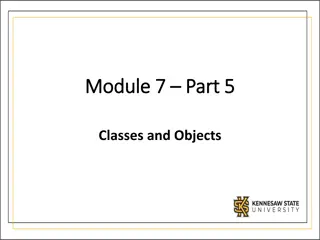Classes and Collections
In this course material, explore topics such as classes and collections, constructor chaining, point cloning, testing for object equality, static methods/fields, and multi-class systems in Java programming. Understand the conventions, implementations, and best practices for creating and managing objects in a programming environment.
Download Presentation

Please find below an Image/Link to download the presentation.
The content on the website is provided AS IS for your information and personal use only. It may not be sold, licensed, or shared on other websites without obtaining consent from the author.If you encounter any issues during the download, it is possible that the publisher has removed the file from their server.
You are allowed to download the files provided on this website for personal or commercial use, subject to the condition that they are used lawfully. All files are the property of their respective owners.
The content on the website is provided AS IS for your information and personal use only. It may not be sold, licensed, or shared on other websites without obtaining consent from the author.
E N D
Presentation Transcript
Classes and Collections CSCI 162 Introduction to Programming II William Killian
Calling another constructor public class Point { private int x; private int y; public Point() { this(0, 0); // calls (x, y) constructor } public Point(int x, int y) { this.x = x; this.y = y; } ... } Avoids redundancy between constructors Only a constructor (not a method) can call another constructor
Copying Points Convention is to use clone method Point p1 = new Point (3, 4); Point p2 = p1.clone (); Class must implement Cloneable interface public class Point implements Cloneable { ... } Must override Object.clone ()
Copying Points Implementing clone public Point clone () { Point p; try { p = (Point) super.clone (); } catch (CloneNotSupportedException e) { throw new RuntimeException ( Class doesn t implement the Cloneable interface ); } // No further work necessary // Memberwise copy is done by default return p; }
Testing for Equality The == operator tests for identity for reference types Want to test Point objects for equality Point p1, p2; ... if (p1.equals (p2)) ... User may compare Point s to other Object s if (p1.equals ( hi! )) ... o Want false to be returned
Point Class public boolean equals (Object obj) { if (!(obj instanceof Point)) { return false; Point p = (Point) obj; return x == p.x && y == p.y; } See Code directory on course page for entire Point class
Multi-class systems Most large software systems consist of many classes oOne main class runs and calls methods of the others Advantages: ocode reuse osplits up the program logic into manageable chunks Main Class #1 main method1 method2 Class #2 Class #3 method3 method5 method4 method6
Redundant program 1 // This program sees whether some interesting numbers are prime. public class Primes1 { public static void main(String[] args) { int[] nums = {1234517, 859501, 53, 142}; for (int i = 0; i < nums.length; i++) { if (isPrime(nums[i])) { System.out.println(nums[i] + " is prime"); } } } // Returns the number of factors of the given integer. public static int countFactors(int number) { int count = 0; for (int i = 1; i <= number; i++) { if (number % i == 0) { count++; // i is a factor of the number } } return count; } // Returns true if the given number is prime. public static boolean isPrime(int number) { return countFactors(number) == 2; } }
Redundant program 2 // This program prints all prime numbers up to a maximum. public class Primes2 { public static void main(String[] args) { Scanner console = new Scanner(System.in); System.out.print("Max number? "); int max = console.nextInt(); for (int i = 2; i <= max; i++) { if (isPrime(i)) { System.out.print(i + " "); } } System.out.println(); } // Returns true if the given number is prime. public static boolean isPrime(int number) { return countFactors(number) == 2; } // Returns the number of factors of the given integer. public static int countFactors(int number) { int count = 0; for (int i = 1; i <= number; i++) { if (number % i == 0) { count++; // i is a factor of the number } } return count; } }
Classes as modules module: A reusable piece of software, stored as a class. oExample module classes: Math, Arrays, System // This class is a module that contains useful methods // related to factors and prime numbers. public class Factors { // Returns the number of factors of the given integer. public static int countFactors(int number) { int count = 0; for (int i = 1; i <= number; i++) { if (number % i == 0) { count++; } } return count; } // Returns true if the given number is prime. public static boolean isPrime(int number) { return countFactors(number) == 2; } }
More about modules A module is a partial program, not a complete program. oIt does not have a main. You don't run it directly. oModules are meant to be utilized by other client classes. Syntax: class.method(parameters); Example: int factorsOf24 = Factors.countFactors(24);
Using a module // This program sees whether some interesting numbers are prime. public class Primes { public static void main(String[] args) { int[] nums = {1234517, 859501, 53, 142}; for (int i = 0; i < nums.length; i++) { if (Factors.isPrime(nums[i])) { System.out.println(nums[i] + " is prime"); } } } } // This program prints all prime numbers up to a given maximum. public class Primes2 { public static void main(String[] args) { Scanner console = new Scanner(System.in); System.out.print("Max number? "); int max = console.nextInt(); for (int i = 2; i <= max; i++) { if (Factors.isPrime(i)) { System.out.print(i + " "); } } System.out.println(); } }
Modules in Java libraries // Java's built in Math class is a module public class Math { public static final double PI = 3.14159265358979323846; ... public static int abs(int a) { if (a >= 0) { return a; } else { return -a; } } public static double toDegrees(double radians) { return radians * 180 / PI; } }
Static members static: Part of a class, rather than part of an object. oObject classes can have static methods and fields. oFields not copied into each object; shared by all objects class state: private static int staticFieldA private static String staticFieldB behavior: public static void someStaticMethodC() public static void someStaticMethodD() object #1 object #2 object #3 state: int field2 double field2 behavior: public void method3() public int method4() public void method5() state: int field1 double field2 behavior: public void method3() public int method4() public void method5() state: int field1 double field2 behavior: public void method3() public int method4() public void method5()
Static fields private static typename; or, private static typename = value; oExample: private static int theAnswer = 42; static field: Stored in the class instead of each object. oA "shared" global field that all objects can access and modify. oLike a class constant, except that its value can be changed.
Accessing static fields From inside the class where the field was declared: fieldName // get the value fieldName = value; // set the value From another class (if the field is public): ClassName.fieldName // get the value ClassName.fieldName = value; // set the value ogenerally static fields are not public unless they are final Example: A BankAccount class in which each account is automatically given a unique ID.
BankAccount solution public class BankAccount { // Static count of how many accounts are created // (only one count shared for the whole class) private static int objectCount = 0; // Fields (replicated for each object) private String name; private int id; public BankAccount() { objectCount++; // advance the id, and id = objectCount; // give number to account } ... public int getID() { // return this account's id return id; } }
Static methods // the same syntax you've already used for methods public static typename(parameters) { statements; } static method: Stored in a class, not in an object. oShared by all objects of the class, not replicated. oDoes not have any implicit parameter, this; therefore, cannot access any particular object's fields. Exercise: Make it so that clients can find out how many total BankAccount objects have ever been created.
BankAccount solution public class BankAccount { // Static count of how many accounts are created // (only one count shared for the whole class) private static int objectCount = 0; // Clients can call this to find out # accounts created public static int getNumAccounts() { return objectCount; } // Fields (replicated for each object) private String name; private int id; public BankAccount() { objectCount++; // advance the id, and id = objectCount; // give number to account } ... public int getID() { // return this account's id return id; } }
Summary of Java classes A class is used for any of the following in a large program: oa program : Has a main and perhaps other static methods. example: GuessingGame, Birthday, MadLibs, CritterMain does not usually declare any static fields (except final) oan object class : Defines a new type of objects. example: Point, BankAccount, Date, Critter, FratGuy declares object fields, constructor(s), and methods might declare static fields or methods, but these are less of a focus should be encapsulated (all fields and static fields private) oa module : Utility code implemented as static methods. example: Math
Exercise Write a program that reads a file and displays the words of that file as a list. oFirst display all words. oThen display them with all plurals (ending in "s") capitalized. oThen display them in reverse order. oThen display them with all plural words removed. Should we solve this problem using an array? oWhy or why not?
Naive solution String[] allWords = new String[1000]; int wordCount = 0; Scanner input = new Scanner(new File("data.txt")); while (input.hasNext()) { String word = input.next(); allWords[wordCount] = word; wordCount++; } Problem: You don't know how many words the file will have. oHard to create an array of the appropriate size. oLater parts of the problem are more difficult to solve. Luckily, there are other ways to store data besides in an array.
Collections collection: an object that stores data othe objects stored are called elements osome collections maintain an ordering; some allow duplicates otypical operations: add, remove, clear, contains (search), size oexamples found in the Java class libraries: ArrayList, LinkedList, HashMap, TreeSet, PriorityQueue oall collections are in the java.util package import java.util.*;
Lists list: a collection storing an ordered sequence of elements oeach element is accessible by a 0-based index oa list has a size oelements can be added to the front, back, or elsewhere oin Java, a list can be represented as an ArrayList object
Idea of a list Rather than creating an array of boxes, create an object that represents a "list" of items. (initially an empty list.) [] You can add items to the list. oThe default behavior is to add to the end of the list. [hello, ABC, goodbye, okay] The list object keeps track of the element values that have been added to it, their order, indexes, and its total size. oThink of an "array list" as an automatically resizing array object. oInternally, the list is implemented using an array and a size field.
ArrayList methods add(value) add(index, value) appends value at end of list inserts given value just before the given index, shifting subsequent values to the right removes all elements of the list returns first index where given value is found in list (-1 if not found) returns the value at given index removes/returns value at given index, shifting subsequent values to the left replaces value at given index with given value returns the number of elements in list returns a string representation of the list such as "[3, 42, -7, 15]" clear() indexOf(value) get(index) remove(index) set(index, value) size() toString()
ArrayList methods 2 addAll(list) addAll(index, list) contains(value) containsAll(list) equals(list) iterator() listIterator() lastIndexOf(value) returns last index value is found in list (-1 if not found) remove(value) finds and removes the given value from this list removeAll(list) removes any elements found in the given list from this list retainAll(list) removes any elements not found in given list from this list subList(from, to) returns the sub-portion of the list between indexes from (inclusive) and to (exclusive) toArray() returns the elements in this list as an array adds all elements from the given list to this list (at the end of the list, or inserts them at the given index) returns true if given value is found somewhere in this list returns true if this list contains every element from given list returns true if given other list contains the same elements returns an object used to examine the contents of the list (seen later)
Type Parameters (Generics) ArrayList<Type> name = new ArrayList<Type>(); When constructing an ArrayList, you must specify the type of elements it will contain between < and >. oThis is called a type parameter or a generic class. oAllows the same ArrayList class to store lists of different types. ArrayList<String> names = new ArrayList<String>(); names.add("Bert"); names.add("Ernie");
Learning about classes The Java API Specification is a huge web page containing documentation about every Java class and its methods. oThe link to the API Specs is on the instructor web site (under Resources).
ArrayList vs. array construction String[] names = new String[5]; ArrayList<String> list = new ArrayList<String>(); storing a value names[0] = "Jessica"; list.add("Jessica"); retrieving a value String s = names[0]; String s = list.get(0);
ArrayList vs. array 2 doing something to each value that starts with "B" for (int i = 0; i < names.length; i++) { if (names[i].startsWith("B")) { ... } } for (int i = 0; i < list.size(); i++) { if (list.get(i).startsWith("B")) { ... } } seeing whether the value "Benson" is found for (int i = 0; i < names.length; i++) { if (names[i].equals("Benson")) { ... } } if (list.contains("Benson")) { ... }
Exercise, revisited Write a program that reads a file and displays the words of that file as a list. oFirst display all words. oThen display them in reverse order. oThen display them with all plurals (ending in "s") capitalized. oThen display them with all plural words removed.
Exercise solution (partial) ArrayList<String> allWords = new ArrayList<String>(); Scanner input = new Scanner(new File("words.txt")); while (input.hasNext()) { String word = input.next(); allWords.add(word); } System.out.println(allWords); // remove all plural words for (int i = 0; i < allWords.size(); i++) { String word = allWords.get(i); if (word.endsWith("s")) { allWords.remove(i); i--; } }
ArrayList as parameter public static void name(ArrayList<Type> name) { Example: // Removes all plural words from the given list. public static void removePlural(ArrayList<String> list) { for (int i = 0; i < list.size(); i++) { String str = list.get(i); if (str.endsWith("s")) { list.remove(i); i--; } } } You can also return a list: public static ArrayList<Type> methodName(params)
ArrayList of primitives? The type you specify when creating an ArrayList must be an object type; it cannot be a primitive type. // illegal -- int cannot be a type parameter ArrayList<int> list = new ArrayList<int>(); But we can still use ArrayList with primitive types by using special classes called wrapper classes in their place. // creates a list of ints ArrayList<Integer> list = new ArrayList<Integer>();
Wrapper classes Primitive Type Wrapper Type int double char boolean Integer Double Character Boolean A wrapper is an object whose sole purpose is to hold a primitive value. Once you construct the list, use it with primitives as normal: ArrayList<Double> grades = new ArrayList<Double>(); grades.add(3.2); grades.add(2.7); ... double myGrade = grades.get(0);
Exercise Write a program that reads a file full of numbers and displays all the numbers as a list, then: oPrints the average of the numbers. oPrints the highest and lowest number. oFilters out all of the even numbers (ones divisible by 2).
Exercise solution (partial) ArrayList<Integer> numbers = new ArrayList<Integer>(); Scanner input = new Scanner(new File("numbers.txt")); while (input.hasNextInt()) { int n = input.nextInt(); numbers.add(n); } System.out.println(numbers); filterEvens(numbers); System.out.println(numbers); ... // Removes all elements with even values from the given list. public static void filterEvens(ArrayList<Integer> list) { for (int i = list.size() - 1; i >= 0; i--) { int n = list.get(i); if (n % 2 == 0) { list.remove(i); } } }
Other Exercises Write a method reverse that reverses the order of the elements in an ArrayList of strings. Write a method capitalizePlurals that accepts an ArrayList of strings and replaces every word ending with an "s" with its uppercased version. Write a method removePlurals that accepts an ArrayList of strings and removes every word in the list ending with an "s", case-insensitively.
Out-of-bounds Legal indexes are between 0 and the list's size() - 1. oReading or writing any index outside this range will cause an IndexOutOfBoundsException. ArrayList<String> names = new ArrayList<String>(); names.add("Marty"); names.add("Kevin"); names.add("Vicki"); names.add("Larry"); System.out.println(names.get(0)); // okay System.out.println(names.get(3)); // okay System.out.println(names.get(-1)); // exception names.add(9, "Aimee"); // exception index 0 1 2 3 value Marty Kevin Vicki Larry
ArrayList "mystery" ArrayList<Integer> list = new ArrayList<Integer>(); for (int i = 1; i <= 10; i++) { list.add(10 * i); // [10, 20, 30, 40, ..., 100] } What is the output of the following code? for (int i = 0; i < list.size(); i++) { list.remove(i); } System.out.println(list); Answer: [20, 40, 60, 80, 100]
ArrayList "mystery" 2 ArrayList<Integer> list = new ArrayList<Integer>(); for (int i = 1; i <= 5; i++) { list.add(2 * i); // [2, 4, 6, 8, 10] } What is the output of the following code? int size = list.size(); for (int i = 0; i < size; i++) { list.add(i, 42); // add 42 at index i } System.out.println(list); Answer: [42, 42, 42, 42, 42, 2, 4, 6, 8, 10]
ArrayList as parameter public static void name(ArrayList<Type> name) { Example: // Removes all plural words from the given list. public static void removePlural(ArrayList<String> list) { for (int i = 0; i < list.size(); i++) { String str = list.get(i); if (str.endsWith("s")) { list.remove(i); i--; } } } You can also return a list: public static ArrayList<Type> methodName(params)
Exercise Write a method addStars that accepts an array list of strings as a parameter and places a * after each element. oExample: if an array list named list initially stores: [the, quick, brown, fox] oThen the call of addStars(list); makes it store: [the, *, quick, *, brown, *, fox, *] Write a method removeStars that accepts an array list of strings, assuming that every other element is a *, and removes the stars (undoing what was done by addStars above).
Exercise solution public static void addStars(ArrayList<String> list) { for (int i = 1; i < list.size(); i += 2) { list.add(i, "*"); } } public static void removeStars(ArrayList<String> list) { for (int i = 0; i < list.size(); i++) { list.remove(i); } }
Exercise Write a method intersect that accepts two sorted array lists of integers as parameters and returns a new list that contains only the elements that are found in both lists. oExample: if lists named list1 and list2 initially store: [1, 4, 8, 9, 11, 15, 17, 28, 41, 59] [4, 7, 11, 17, 19, 20, 23, 28, 37, 59, 81] oThen the call of intersect(list1, list2) returns the list: [4, 11, 17, 28, 59]
Other Exercises Write a method reverse that reverses the order of the elements in an ArrayList of strings. Write a method capitalizePlurals that accepts an ArrayList of strings and replaces every word ending with an "s" with its uppercased version. Write a method removePlurals that accepts an ArrayList of strings and removes every word in the list ending with an "s", case-insensitively.























